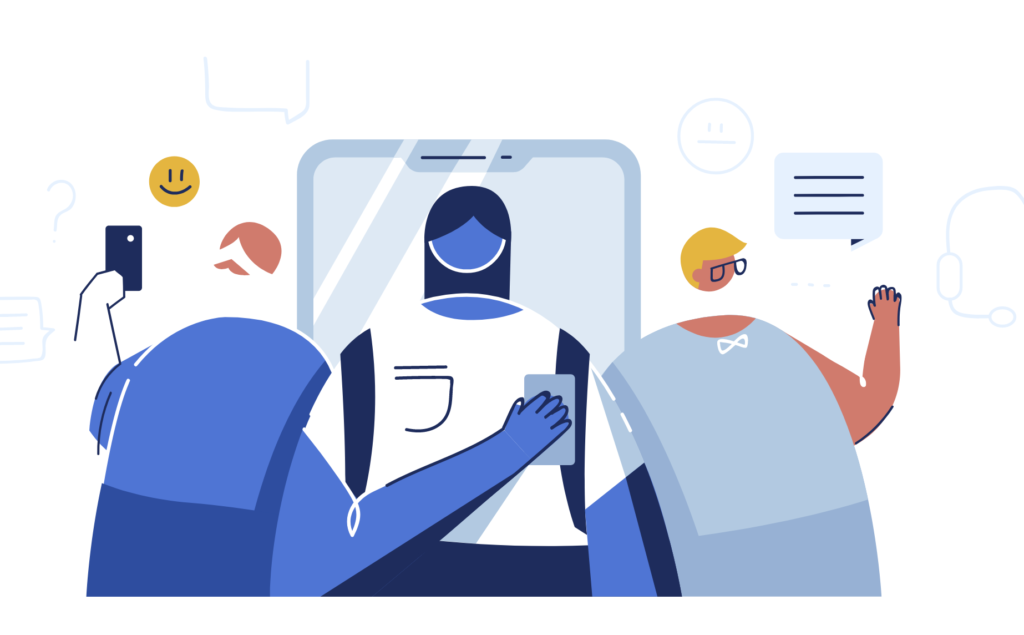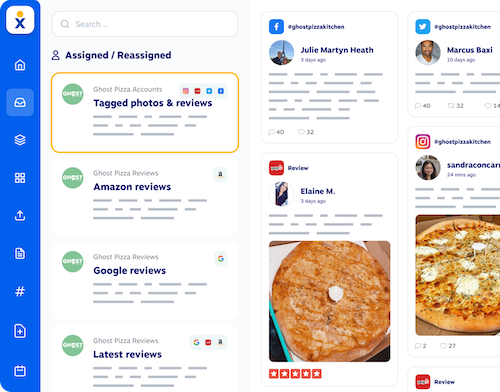Brands must work harder for customer loyalty, thanks to limitless choices within almost every industry. It’s not only product and price that companies must compete on, but a company’s customer service is a true differentiator.
Good customer service is vital to business, but how critical is it? A few decades ago, customer service channels were nearly non-existent; now, they’re essential to any successful business.
So, how can companies of all sizes deliver excellent customer service? For starters, a strong customer service philosophy makes a huge difference. But read on for more tips.
Advances like cloud-based business phone systems have raised customer expectations. Shifting sentiment by younger consumers has placed a greater demand on the role of customer service. Likewise, a company’s social media interactions happen publicly versus privately.
Here are 100+ insightful customer service stats to help your company deliver a seamless customer journey.
- State of the customer service experience
- Building brand loyalty
- Reaping the rewards of good customer service
- Poor customer service loses out
- Millennials and Gen Z drive demand
- Handling customer feedback
- Social media and customer service
- The rise of artificial intelligence and automation
- Ask the customer experience experts
- 2024 customer service trends
The State of Customer Service

- Customer expectations are higher than ever, a sentiment 93% of customer service teams agree with. (HubSpot)
- Eight in 10 people regularly have negative experiences with customer service. Customers want improved prices and fees, product capabilities, and ease of use. (Qualtrics)
- 71% of customer support leaders experienced an increase in overall contact volume since February 2020 and expected that trend to continue. (FreshWorks)
- 74% of U.S. consumers said they had a bad customer service experience with a product or service in 2022 — an 8% increase over 2021. (WSJ)
- Customer satisfaction hit during the pandemic, with the national American Customer Satisfaction Index reported at 73.4 in Q4 2022. (ACSI)
- Since the pandemic, consumers have become targets of fraud, furthering distrust of offers and messaging from unfamiliar sources. Fraud losses exceeded $1.03 billion. (FTC)
- 68% of people feel brands should have personalized experiences in every interaction; the same expectation applies to customer support. (Acxiom)
- Organizations have invested in customer success, with 91% of customer service reps reporting their team had grown between 2020 and 2021. (Totango)
- The pandemic has led customer service team leaders to move to cloud technology to meet customers’ needs better. 75% also said they plan to move to a cloud contact center by 2024. (Deloitte)
- Consumers today are more focused on “we” than “me,” with 63% of consumers saying they are more attracted to brands focusing on making the world a better place. (Edelman)
- 45% of companies actively provide training to customers, and most agree it improves client relations. (Docebo)
- Average weekly customer service issues have been up 20% since the start of the pandemic. (Zendesk)
Related: 10 Ways to Spark Social Media Conversations (with Examples)
Brand Building & Building Brand Loyalty

- Seven out of 10 customers have stopped doing business with a brand due to a poor customer service experience. (Verint)
- Eight out of ten consumers expect brands to do more than provide good customer service, such as giving money to good causes and addressing societal challenges. (Edelman)
- 76% of people “always” or “regularly” read online reviews for local businesses. (BrightLocal)
- More than half of consumers (60%) have posted a new customer review when prompted by the brand in the last 12 months. (BrightLocal)
- Consumers are 5.1 times more likely to recommend a brand after an excellent customer service experience. They’re also 3.5 times more likely to purchase from a business after positive customer experiences. (Qualtrics)
- 68% of customers said a positive customer experience over a particular messaging channel significantly improved their brand loyalty. (Conversocial)
- ‘Brand’ is the full summation of your customer’s experience with and connection to your company. (American Express)
- The most important review factors for consumers are 1. Star rating, 2. Legitimacy, 3. Recency, 4. Sentiment, and 5. Quantity. (BrightLocal)
- Featuring customer reviews on a landing page can increase conversion rates by up to 270% (Spiegel Research)
- 83% of customers would use a community forum for self-service support knowledge base. (Vanilla Forums)
- Customer-centricity is a growing trend among companies known for great customer service, with 77% of front-line reps saying their company views them as customer advocates. (Salesforce)
- The best way for customers to have a positive customer experience after purchasing a SaaS app is to receive personalized guidance to use the product. (Cognism)
- Nine out of 10 U.S. consumers are likely to use a business when responding to positive and negative reviews. (BrightLocal)
Reaping the Rewards of Good Customer Service

- 91% of customers say they’re more likely to make another purchase after a great customer service experience. (Salesforce)
- Almost two-thirds of consumers say they are more likely to forgive a mistake by a long-term favored brand than a brand they have only done business with for a year or less. (Deloitte)
- 63% of consumers expect customer service agents to know their unique needs and expectations. (Salesforce)
- 63% of consumers say they’d be willing to share more information with a company that offers a great experience. (PwC)
- Consumers who report a good customer service experience are 38% more likely to recommend that company than consumers who received bad customer service. (Qualtrics)
- 28% of consumers learn about a new brand, product, or service by word of mouth. Yet, only 4% of marketers attribute sales to word of mouth. (RRD)
- 94% of consumers who give a company a great customer service experience rating are likely to purchase more products or services from that company in the future. (Qualtrics)
- Personalized experiences are more important than personalized messaging to 79% of consumers. (Gladly)
- More than two-thirds of customers (68%) expect brands should demonstrate empathy in communication channels. (Salesforce)
- Earned growth is a customer service metric that measures the quality of your company’s growth between existing customers, net-new accounts, and referrals. (SentiSum)
- Increasing customer retention rates (lower customer churn) by 5% increases profits by 25-95%. (Harvard Business School)
- About three-quarters of consumers who give a company a “very good” customer experience rating are likely to forgive a company for a bad experience. (Qualtrics)
- 78% of customers expect a brand/product to have self-service options over traditional customer service channels. (Document360)
Poor Customer Service Loses Out

- Bad experiences cost businesses $4.7 trillion in global consumer spending every year. (Qualtrics)
- 42% of consumers would pay more for a friendly, welcoming customer service experience. (PwC)
- Companies with poor customer service could potentially achieve 25–95% more profits. (Bain & Company)
- 37% of consumers abandon a purchase or post a negative review with a poor digital shopping experience. (SiteCore)
- The most frustrating aspect of customer service is the hold time when waiting for a customer support rep. (Zendesk)
- Only one in five customers who gave a company a poor customer service experience rating are likely to purchase more goods from the company in the future. (Qualtrics)
- 13% of those who gave a company a bad customer service experience rating are likely to recommend a company to others. (Qualtrics)
- Every week, 14% of business professionals deal with a service issue with a communication channel that creates a short-term communications crisis. (Nextiva)
- 27% of Americans report “lack of effectiveness” as their top frustration with customer service reps. (Statista)
- 12% of Americans rate their highest frustration with customer service as “lack of speed.” (Statista)
- Only 15% of those who gave a company a “very poor” customer experience rating are likely to forgive a company for a bad experience. (Qualtrics)
- Reviews are a popular form of customer engagement, with 72% of U.S. consumers saying they have written a review for a local business. (BrightLocal)
- Providing bad customer service risks $494 billion due to customer churn and brand damage. (CCMC)
- About half (49%) of customers’ social media complaints go unaddressed by businesses. (ASU)
- Only 48% of consumers would consider buying a good or service from a business with fewer than four stars. (BrightLocal)
- 17% of consumers are likely to raise awareness about a bad customer service experience with friends and neighbors. (CCMC)
- Dissatisfied customers tell twice as many people about their poor customer service experience than those with a positive customer experience. (CCMC)
Millennials & Gen Z Drive Demand

- Gen Z accounted for an estimated 40% of global customers. (McKinsey)
- In 2019, 61% of Millennial consumers in the United States stated they would be willing to pay more for quality customer service. (Statista)
- 14% of Millennials say they would take to social media or a brand’s website to share a review and give feedback. (Retail Drive)
- 62% of Millennials report seeking an unofficial knowledge base (such as a subreddit, Twitter, or YouTube video) as a self-service option for service issues, even with 24/7 customer support available. (Gartner)
- Among Millennials, 35% said they prefer email, making it the most-used customer service channel for support interaction. (Hiver)
- 14% of Gen Zers value empathy from customer support reps, more so than their Millennial (11%) and Baby Boomer (6%) cohorts. (Hiver)
- 63% of Gen Zers say that mobile experience is a top factor in customer satisfaction. (PwC)
- 77% of Gen Zers expect companies to offer new ways to get existing products, such as digital versions of traditionally in-person experiences. (Salesforce)
- 60% of all B2B tech buyers are now Millennials and 2% are from Generation Z. (TrustRadius)
Handling Customer Feedback

- More than four in five customers expect to immediately talk with a customer service agent when contacting a company. (Salesforce)
- Most companies cannot engage with customers via live chat or a chatbot. So much so that they’re more likely to text than chat by a 3:1 ratio. (Nextiva)
- The top 10 preferred communication channels are email, phone, in-person, online chat, mobile apps, messenger apps, text/SMS, online portals, video chat, and social media. (Salesforce)
- More than two-thirds of customers say they want an organization to “reach out and engage with proactive customer notifications.” (Microsoft)
- Since 2016, customer conversations have shifted from public social to private messaging channels by 36%. (Conversocial)
- American consumers say that phone and online chat are the easiest communication channels. (Statista)
- People under 40 prefer using branded apps, texting, and chatbots. Those over 40 favored more traditional channels such as call centers and email. (Shep Hyken)
- 87% of customer service representatives say customers have increased their use of digital channels like social media during the pandemic. (Salesforce)
- Nearly one-third of customers report sending an SMS text message to the company requesting assistance. (Forrester)
- 57% of service professionals believe automated voice assistants will become a top customer communication channel. (Salesforce)
- Customers use an average of nine channels to browse inventory, seek advice, and make purchases. (Salesforce)
- American consumers say that social media is the most difficult communication channel. (Statista)
- 71% of customer service employees say switching between multiple communication channels has made it challenging to meet customer needs. (Nextiva)
- Customer data is rated the most useful data source for B2B (39%) and B2C (42%) for marketing effectiveness. (Oracle)
- 86% of consumers expect seamless communication across multiple channels with customer support agents. (Gladly)
- 42% of adults prefer to resolve their issues over the phone, compared to digital channels like knowledge bases (38%) and email (20%). (Statista)
- Only 12% of self-service support platforms are highly integrated; for most organizations, only 20% of service issues are resolved. (McKinsey)
- Two in five U.S. consumers say they’ve used three or more channels to reach a company’s customer service team. (Airkit)
- By 2025, proactive customer service teams will outnumber reactive customer service interactions. (Gartner)
- Reaching a business via the phone remains the most popular customer service channel method (Cornell University)
Social Media & Customer Service

- 48% of consumers expect a response to social media questions and complaints within 24 hours. (Statista)
- Just one-third of consumers in the United States don’t expect a response when asking a question via a company’s social media. (Statista)
- More than half (54%) of casual social media lurkers research products and services. (Global Web Index)
- At least one in three consumers follow brands they like on Facebook, YouTube, and Instagram — and those social media platforms are also where engagement is most likely to happen. (RRD)
- Social media micro-influencers with fewer than 500,000 followers have conversion rates that are six times higher than Facebook ads. (Ubiquitous)
- 18% of consumers expect a response from a company’s social media within one hour of their message. (Statista)
- Online users spend two hours and 28 minutes per day on social media. (DataReportal)
- Companies respond to social media users faster, with 59% of responses happening within 15 minutes. (Gartner)
The Rise of Artificial Intelligence & Automation

- One in three decision-makers implementing AI state that predicting customer needs and delivering personalized experiences is a key consideration to drive ROI. (Forrester)
- Classifying service issues with artificial intelligence (AI) and automatic routing of incoming customer contacts increases contact center agent productivity by 1.2 hours a day. (Freshworks)
- Nearly two-thirds of customer service tasks and up to 70% of contacts can be automated with an AI-powered omnichannel contact center solution (McKinsey)
- 79% of businesses consider automation necessary in their customer experience strategy. (Verint)
- 74% of consumers prefer a callback option instead of waiting on hold for a customer service rep. (SupportYourApp)
- Customer support response times influence customer satisfaction (CSAT) scores the most. (Freshworks)
- 38% of B2B decision-makers say their organization used chatbots in 2020, an increase of 67% from 2018. (Salesforce)
- 54% of customers have had a poor customer service experience when engaging with a chatbot. (Conversocial)
- 71% of Americans would rather interact with a human than a chatbot or automated process. (PwC)
Ask the Customer Experience Experts

- “Your most unhappy customers are your greatest source of learning.” — Bill Gates
- “If you do build a great experience, customers tell each other about that. Word of mouth is very powerful.” — Jeff Bezos
- “I can’t stress how important it is for companies and their support teams to place themselves deep in their customers’ shoes, understand how their expectations are currently evolving, and provide support that is more human and relatable.” — Dan Gingiss
- “Companies that show that they are willing to invest in their customers even if it doesn’t contribute to short-term results will be the winners of tomorrow“ — Steven Van Belleghem
- “Customers do not care how much you know unless they know how much you care.” — Damon Richards
- “The most dangerous customers aren’t your haters; they are the ‘meh’ in the middle, the dissatisfied customers who don’t take the time to complain.” — Jay Baer
- “I’ve learned that people will forget what you said, people will forget what you did, but people will never forget how you made them feel.” — Maya Angelou
Related: The Top 50 Customer Service Experts of the Decade
2024 Customer Service Trends
As we look toward the future of customer service, there are a few rising customer service trends for 2024 to take into consideration:
Trend #1: Omnichannel is here to stay

An omnichannel approach to customer service is becoming increasingly important. This means offering a seamless experience across all your customers’ communication channels, not just live chat.
With an omnichannel contact center, you can provide consistent and unified customer service, which is essential in meeting the needs of today’s customers. While implementing such an approach may be challenging, ensuring your organization remains competitive in the current business landscape is crucial.
Trend #2: Personalized customer experiences
Companies that leverage customer data effectively can improve every step of the customer journey and will thrive in 2024 and beyond. These interactions also parlay into customer service representatives providing personalized experiences.
Investing in mature customer experience tools like Nextiva builds strong relationships with their customers, which is essential to business growth.
Trend #3: Tap into workforce flexibility
In today’s world, it’s becoming increasingly common for customer service teams to work remotely, in the office, and hybrid locations. Customer service leaders invest in networking equipment, analytics, cloud communications, and collaboration tools to keep agents connected and working together.
Although some firms resist working from home, you can deliver excellent customer service regardless of where your team works. Unified communications providers like Nextiva keep everyone connected and display every customer interaction’s full context.
Trend #4: The practical uses of artificial intelligence
The use of Artificial Intelligence (AI) and chatbots in customer service has long been discussed. But only recently, it’s become a reality. Companies can implement these tools to save customers time, direct callers to the best customer service agent, and even resolve concerns automatically.
AI and chatbots can respond to customer queries, update customer data systems, and render a more personal customer experience.
Additionally, these tools can manage simpler customer service requests, freeing up live agents to focus on more complex interactions that need a personal touch.
Trend #5: Prioritize customer service agent happiness
Since customer interactions have swelled during the pandemic, customer service agents have carried a heavy burden. To improve morale and reduce call center turnover, focus on enhancing the agent experience.
Encouraging greater autonomy and flexibility is paramount. By investing in better customer support tools, chat bots, cloud phone service, and automating repetitive workflow steps, companies can help customer service teams agents provide a superior customer experience because they’re genuinely happier.
Trend #6: Respond to customer reviews to strengthen brand reputation
Customer reviews are essential to an effective marketing strategy. Ensure that every piece of customer feedback is reviewed and addressed. Online reviews have a significant impact on customer acquisition and customer retention.
Reply to each review (good and bad) consistently with a reputation management tool. This will help your brand maintain its online reputation and prove your commitment to excellent customer service.
Related: How To Build an Incredible Brand Reputation From Scratch



